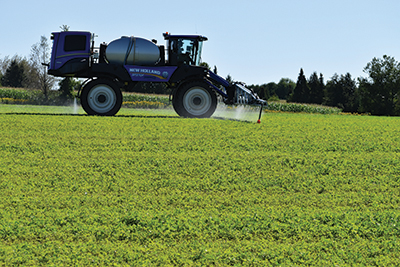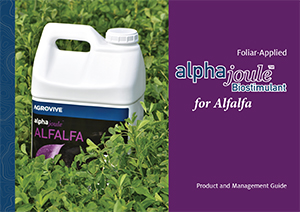Management of Alfalfa with alphajoule Biostimulant by Foliar Application
Easy to Apply
 alphajoule is a liquid biostiumlant product that can be managed by spraying, fertigation with an irrigation system, or air applied. The biostimulant can be applied to all alfalfa varieties and technologies at spring green-up and following each harvest during the growing season. alphajoule supports improved yield, expands harvest flexibility, and replenishes root reserves for the next crop.
alphajoule is a liquid biostiumlant product that can be managed by spraying, fertigation with an irrigation system, or air applied. The biostimulant can be applied to all alfalfa varieties and technologies at spring green-up and following each harvest during the growing season. alphajoule supports improved yield, expands harvest flexibility, and replenishes root reserves for the next crop.
A case of alphajoule covers 20 acres of established alfalfa. It can also be applied to alfalfa grass mixtures or spring seeded alfalfa.
Each case contains two 2.5-gallon jugs. One jug is alphajoule and the second jug is PRYMER™ for Alfalfa, a bacteria and micronutrient activator. Both products are applied at the rate of one pint per acre in the same tank mix with 10 gallons or more of clean water to deliver 50,000,000 CFUs of beneficial alphajoule bacteria. Because the bacteria are living organisms; producers should apply the tank mix as soon as possible after introducing alphajoule to the mix. Use larger sized nozzles for best crop coverage.
During the growing season, alphajoule is recommended for each crop at green-up to mediate above and below ground stress. Apply alphajoule when the majority of crown buds have released and at least three weeks before the next harvest. This recommendation usually provides a 5-7 day application window after the previous crop’s cut date.
 Tank Mixing
Tank Mixing
alphajoule and PRYMER for Alfalfa are tank mix compatible with other products applied to alfalfa at the green-up stage of growth. This would include micronutrients (except copper), insecticides, herbicides (except glyphosate), and most fungicides. Bacteria are not compatible with chlorine bleach. The alphajoule bacteria are temperature sensitive and have a performance range in the alfalfa plant of 32°-108° F.
There are no restrictions on re-entry or harvest after application of alphajoule and PRYMER. However, other products applied in the same tank mix may have restrictions. Read and follow all label instructions.
Differences between treated and untreated acres may not be easily seen in the field from a distance. Kneeling in the crop will highlight differences in plant height, leaf size, overall leafiness, and auxiliary branching. To confirm these subtle differences, collect representative treated and untreated plants and place side-by-side to evaluate.
The bacteria are removed from the field by harvest and require re-introduction during the next crop’s green-up. The number of bacteria left post-harvest in the crown tissue is usually insufficient to be effective for the next crop. alphajoule bacteria removed from the field in the dry hay or haylage expire during drying or the silage fermentation process.
Southwestern U.S. Management of Alfalfa with Biostimulant
Growers using semi- and non-dormant alfalfa can apply alphajoule with the following adjustments:
- Avoid over dilution by flood irrigation. Apply by ground sprayer, pivot irrigation, or by air.
- For drip irrigation systems, apply alphajoule without PRYMER to reduce native bacteria growth in the lines.
- Apply to spring or fall fields when day time temperatures are under 108°F.
Download the Product and Management Guide
Links
- ROI Calculator
- Product Label
- Safety Data Sheet


